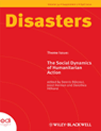
This paper examines the impact of the presence of international humanitarian organisations on local urban transformation processes in the city of Goma, Democratic Republic of the Congo (DRC). Rather than evaluating the direct effects of humanitarian interventions and strategies, it focuses on the indirect but profound effects of the presence of this ‘humanitarian sector’. It argues that the international humanitarian presence became a significant factor in the recent shaping and reshaping of the city's profile and has reinforced competition over the urban political and socioeconomic space. The paper evaluates the direct and indirect impact of the international humanitarian presence on the local urban economy and the larger political economy of war in eastern DRC. It analyses how this presence has reinforced processes of spatial reconfiguration, how it has influenced urban planning, and how it has affected dynamics of gentrification and marginalisation on the urban spatial level.
Links
Resource collections
- UN Habitat - Urban Response Collection
- Urban Response - Urban Crisis Preparedness and Risk Reduction
- Urban Response Collection - Community Engagement and Social Cohesion
- Urban Response Collection - Economic Recovery
- Urban Response Collection - Environment and Climate Change
- Urban Response Collection - Housing, Land and Property
- Urban Response Collection - Urban Crisis Response, Recovery and Reconstruction
- Urban Response Collection - Urban Resilience